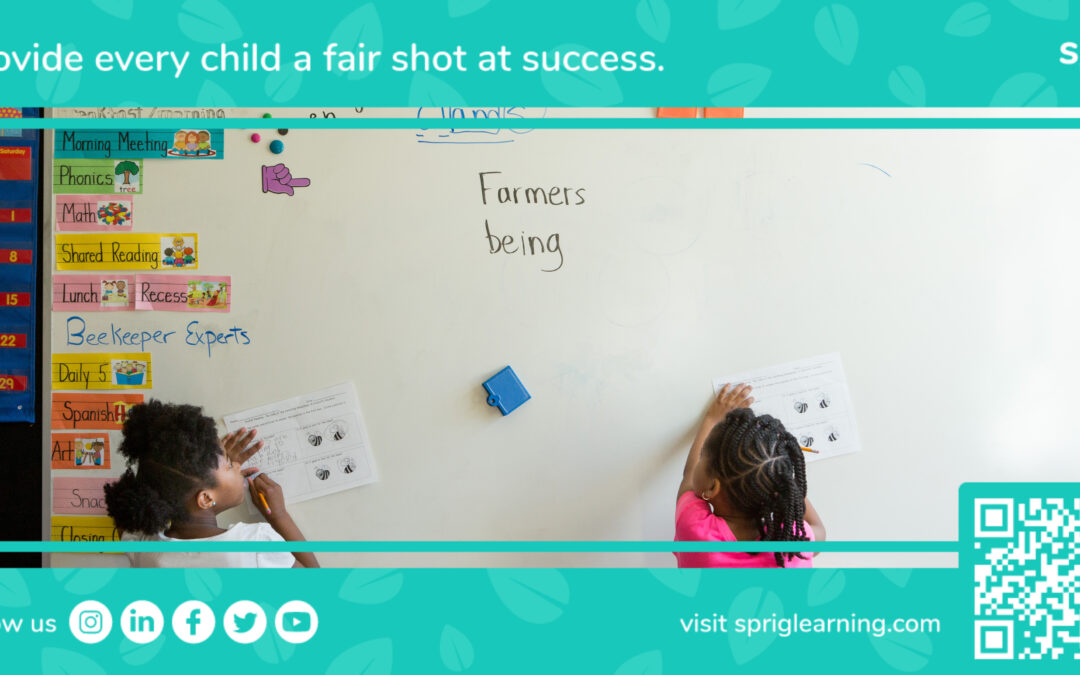nStructured Literacy, as defined by the International Dyslexia Association, refers to highly explicit and systematic teaching of all the critical components of literacy.
In many school districts, there is a growing concern that diverse classrooms of students are not achieving their full potential in reading.
This has led to an increased demand for more structured literacy instruction that provides a comprehensive focus on foundational reading skills, ensuring that every student receives rigorous early literacy support.
Through structured literacy instruction, students who excel in certain areas can naturally advance, while those who struggle in certain areas receive additional instruction and practice, so they do not fall behind and are not left struggling by the time they reach Grade 3.
Teaching reading is both a science and an art, and it is important to learn from experienced early literacy researchers, teachers, specialists, coaches, and interventionists to determine the best practices for effective reading instruction.
This article compiles 15 valuable pieces of advice on how to teach early learners to read from highly experienced literacy specialists, coaches, teachers, and experts.
The individuals featured in this article have dedicated years to researching and implementing the best methods for teaching reading, and their experience and wisdom are unparalleled.
15 Structured Literacy Tips That Can Be Implemented in The Classroom

The information for this article was gathered by asking early literacy experts for their best advice on teaching reading in the classroom, and by identifying published papers or interviews that highlight how their research can be applied to the art of teaching reading.
Without further delay, let us delve into the valuable insights shared by these educators.
1. Use In-class Observation to Design The Right Learning Environment
“There is something so beautiful about the joy and excitement that comes from the connection with texts. Listen closely to the conversations that are happening around you and the way students gravitate towards play. Are they rushing to the kitchen corner? Plant a few cookbooks. Lego lovers? Print a collection of simple builds or find the ‘how-to’ books. Animal lovers? Find your local pet store’s ‘Guides to Owning a…”. Strategically place these gems in the classroom and encourage using the environment as an ever-changing wealth of information.”
– J. Roxanne Young
Early Literacy Specialist and Curriculum Coordinator at Southpointe Academy
Formative assessment goes beyond just quiz scores, but also involves observation.
2. Provide a Multi-sensory Learning Experience To Teach Reading
“An excellent way to support early literacy development is to offer children open-ended, natural materials to manipulate and experience in their learning. When practicing phonemic awareness, they can trace letter shapes in the sand – or form the symbol with sticks or rocks. Open-ended activities such as these, also help support student agency and independence. ”
-Marcella De Diego
Reading Intervention Specialist
Engaging activities and resources are required to teach all the all-important foundational reading skills.
3. Understand How The Brain Processes Information Relating To Reading
“All children have the right to know how to make sense of the lines, squiggles, curves, and dots making up text, whether they are reading someone else’s thoughts or creating their own thoughts in writing. This is the essence of literacy. Every child has the right to understand how the human brain learns to read and spell, as well as a teacher who understands this same information. Attaining literacy is surely not a ‘passive process’. My message to teachers and families: “Be sure YOU understand how the human brain learns to attain literacy as either the teacher or parent of children.” Seek information about the research behind The Science of Reading.
-Lori Josephson
Literacy Coach and Dyslexia Specialist
Knowledge of how reading skills develop gives greater confidence to young learners.
4. Ensure That Decoding Happens Fluently Enough To Lead to Comprehension
“It is not enough for young students to be able to decode words accurately; they also need to develop their word decoding competencies to an automatic and effortless level so that they can read with good expression and focus their attention on reading for meaning. In my mind’s eye, an effective foundational reading curriculum would occur in kindergarten through grade 2. Each day, students would receive the type of literacy instruction that would be considered exemplary: read-aloud by the teacher, authentic reading of stories and dictated texts followed by meaningful response activities, time to read and explore books and other reading material independently, instruction on how words work (phonemic awareness, phonics, and words study), and opportunities to engage in authentic writing.”
-Dr. Tim Rasinski
Professor of Literacy Education at Kent State University, multi-award-winning author and international expert on fluency and word play.
Decoding is only the beginning. Further practice takes the art of decoding to a new level.
5. Focus Efforts Early On To Give Future Readers Their First Breakthrough
“Getting an airplane off the ground is an excellent analogy for what we have to do in the beginning stages of reading acquisition. It does require an inordinate effort and focus on helping children to break the code and understanding these letter sound patterns, and fragmenting and putting them together rapidly so those words become automatized. In our study, what we found was that children who made this breakthrough, who broke the code early on in first grade, not only became better readers in high school, which is what we’d predict, but they engaged in print more.”
-Dr. Anne Cunningham
Literacy development scientist and a special education professor at University of California, Berkeley.
Early literacy intervention is a crucial part of early literacy instruction.
6. Work With The Interests of Your Students
“I begin every year with a quick survey about my students’ favorite topics. The data I collect helps me make instructional decisions that impact my book selections for read-aloud, for guided reading and for my students’ individual book boxes. If I know that Sam is interested in trains, then I might entice him with a book like Freight Train by Donald Crews. After he’s hooked, I’ll hand him an informational book about trains that is a bit more complex but uses the same vocabulary as Freight Train, and so on.”
-Dr. Maria Walther
Teacher, Author and Literacy Consultant
A holistic assessment tries to know everything about the student: their strengths, weaknesses, interests and dislikes.
7. Think of Ways For Students to Actively Participate in The Reading Process
“You can’t drill and skill phonics, that won’t work. Phonics, just like every other aspect of literacy, depends on understanding and thinking. The key to teaching phonics well is not just teaching them their ABCs, you must know the ABCs, but it’s not just teaching them, helping them to learn letter/sound correspondences, but it’s finding a way to get them to think actively about how the whole thing works so they’ll learn.”
-Marilyn Jager Adams
Cognitive and Developmental Psychologist and a Reading Researcher.
8. Give Ample Opportunities for Practicing Taught Concepts
“A large number of studies have shown us that if we explicitly teach and then give students lots of opportunities to practice specific reading comprehension strategies, their reading comprehension will improve and improve much more than it would do just naturally. Some of these studies teach just a single comprehension strategy, and even from teaching just one comprehension strategy, we do see gains in students. Other studies will have students learning several different strategies and implementing those, and again, we see really, in some cases, very substantial growth from the research studies in kids’ reading comprehension abilities even in the very early years of schooling.”
-Dr. Nell Duke
Professor of Literacy at The University of Michigan and Language Expert
Find time for practice in the daily teaching schedule.
9. Engage in Small Group Instruction. It can be as Effective As One-to-One Instruction.
“The effects of three grouping formats—1:1 (one teacher with 1 student), 1:3 (one teacher with 3 students), and 1:10 (one teacher with 10 students)—on the reading outcomes of second-grade struggling readers was studied. Students in all groups were given the same supplemental reading intervention for the same number of sessions, thus holding intervention type and intensity constant and varying group size. Students made significant gains in phoneme segmentation, fluency, and comprehension following the intervention, and these gains were maintained at follow-up (4—5 weeks after intervention). Based on effect sizes, both 1:1 and 1:3 were highly effective intervention group sizes for supplemental reading instruction. Although the 1:1 grouping format yielded significantly higher scores for phoneme segmentation, fluency, and comprehension than the 1:10, it was not superior to the 1:3 on any outcome measure.”
-Dr. Sharon Vaughn.
Literacy researcher and executive director of The Meadows Center for Preventing Educational Risk at The University of Texas at Austin
If individual learning personalization is too much of a draw on resources, small group differentiation can also get the job done.
10. Have a Tracking Mechanism For Literacy Skills.
“Once reading instruction begins, the best predictor of future reading growth is current reading achievement, and the most critical indicators of good progress in learning to read during the early elementary period are measures of word reading skill. Children who end up as poor readers at the end of elementary school are almost invariably those who fail to make normal progress in these skills during the first years of elementary school.”
-Dr. Joseph Torgesen
Emeritus Professor of Psychology and Education at Florida State University and Dyslexia Specialist
Regardless of if it’s diagnostic, formative or summative assessments, all of this assessment data should be made easy to track.
11. Provide Enough Autonomy to Educators Who Know Their Class Best.
Most teachers “credited other exemplary teachers for supporting them and encouraging them to become better teachers and to assume greater professional responsibility for the success of their students. These teachers seemed to understand that professional responsibility meant choosing how to teach, what to teach, and with what sorts of curricular materials and tasks: they rejected the low-autonomy/high-accountability models that seem increasingly popular with advocates of “proven programs.”Instead, these teachers elected a high-autonomy/high accountability model. They seemed to feel no particular pressure from state testing schemes, perhaps because their students performed so well. At the same time, because they were the architects of the instruction offered in their classrooms, they reported a greater sense of responsibility for student outcomes. In other words, these teachers accepted the professional responsibility for developing high levels of reading proficiency but insisted on the autonomy to act on their expertise”.
-Dr. Richard Allington
Professor of Literacy Studies at The University of Tennessee and reading instruction Scholar
Find a tool/resource that will act as a force multiplier to existing best practices.
12. Ensure Adequate Teacher Collaboration.
“Find yourself some friends with whom to work. They make me think of things I have not thought of before. Other people keep you honest, and other people keep you going.”
-Dr. P. David Pearson
Reading Researcher & Professor of education at the University of California, Berkeley
Apart from providing the right professional development, set up a culture of collaboration where teachers can discuss in-class practices amongst themselves to learn and improve.
13. Understand All the Essential Sub-skills of Each Foundational Skill Set
“Phonemic awareness training must include connecting the oral phonemes and the letters that represent them.”
-Joanne Heckbert
Reading and Assessment Specialist and Co-owner of KAS Corporation Ltd.
When teaching a class, it helps to know everything a student needs to know in order to progress to reading mastery.
14. Choose Professional Development That is Backed by Research
As a structured literacy teacher and Orton Gillingham trained interventionist, I know the critical importance of following a pedagogically sound phonemic awareness program such as Equipped for Reading Success by Dr. Kilpatrick. Experts and researchers agree that Phonological and phonemic awareness are the greatest predictors of later reading proficiency.
-Suzanne Diermann
Literacy Specialist at Illuminate Literacy
It helps to rely on professional learning that will help you fulfill your teaching goals, in this case, helping students gain reading proficiency.
15. Think of Fun Ways to Assess For Important Skills
“If your child has difficulty playing “Anomia for kids”, they probably have phonological and possibly phonemic awareness difficulties. Easy and fun way to assess! “
-Barbara Mendes
Experienced Reading Specialist at Reading Routes
Play-based early learning is conducive to reading success.
Structured Literacy Leads to Early Reading Achievement!

We hope that the 15 valuable pieces of advice from these experts compiled in this article have provided you with insight and inspiration for your classroom.
If you are interested in learning more about Structured Literacy and evidence-based practices for effective reading instruction, join us at The HeART and The Science Summit in August.
The Summit will bring together top researchers, practitioners, and advocates to share insights, strategies, and solutions for addressing the reading crisis in North America, including three names mentioned in this very article! Namely: Dr. Rasinski, Dr. Cunningham and Dr. Walthers.
Connect with like-minded educators and learn from leading experts in the field. Register now to reserve your spot!

